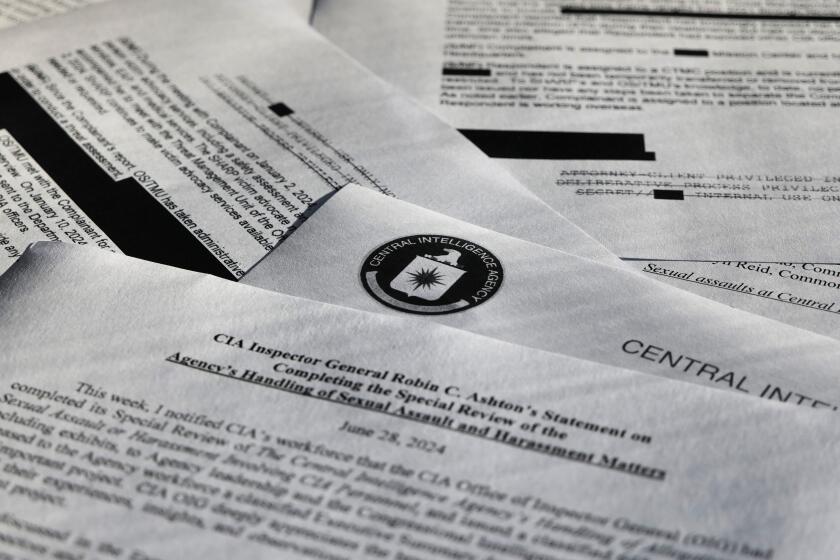The case for graphic war images
Comfortably out of harm’s way and with a lot on our minds, we don’t have much reason to think about the life-threatening reality facing more than 170,000 Americans in Iraq and Afghanistan. They do their duty. We go about our business, inattention enabled by much of the media’s withdrawal from those battlefields.
But occasionally a report from the war zone -- like one last week by National Public Radio’s Soraya Sarhaddi Nelson on the death of a young Marine corporal in Afghanistan -- jolts us from our complacency.
Then again, do we really want to be reminded? From the furious and furiously mixed response to Nelson’s story, it’s clear that, eight years into the war in Afghanistan and nearly seven years after the invasion of Iraq, we have come no closer to agreeing on whether death in combat should be a public or private matter.
Nelson’s Feb. 19 report on “All Things Considered” took us along on a Marine patrol in Marja, scene of a continuing American offensive against the Taliban. NPR’s Kabul bureau chief described the Americans’ four-hour slog, in the face of hit-and-run sniper attacks, that covered just half a mile.
The reporter’s microphone captured the pop and crackle of Taliban guns, the heavy pounding of U.S. machine guns and, just as commanders called a halt before sundown, another sound, of Marines in distress.
“Corpsman up! Corpsman up! Corpsman!” came the cries, followed by a pronounced pause and then Nelson’s strained voice quietly declaring: “He’s dead.”
In a subsequent interview, the NPR correspondent explained how Lance Cpl. Alejandro Yazzie died of a head wound 50 feet away from her. She told of how she had gotten to know Yazzie in the days she had been embedded with his unit.
The reporter, once my colleague at The Times, described Yazzie as a “sweet young man” and compellingly told how he and other Marines had borrowed her satellite phone to call wives and girlfriends on Valentine’s Day.
Yazzie couldn’t get through to his wife and talked on the morning of his last day of how he really wanted to try to reach her again. Nelson agreed. But he never got the chance.
“I am just so sorry he never got to communicate with her again,” Nelson told me Friday from NPR’s Kabul bureau, where she had just been shaken awake by a nearby car bombing. “I hope to tell his wife some day that I did get to know her husband and he was thinking about her a lot.”
The story of Yazzie’s death struck a particular chord because of that human connection. And because the media have so seldom delivered vivid casualty reports from the combat zone. Pictures of the Americans wounded and, especially, those killed in combat have been almost nonexistent.
Back in 2005, I reviewed coverage of casualties in six prominent U.S. papers over a six-month period and found virtually no pictures from Iraq of Americans killed in action. And not much has changed since then, despite the fact that the American death toll in Iraq and Afghanistan has climbed to well over 5,000.
A substantial minority of Americans continue to argue that the media and the public have no business witnessing a soldier’s dying moments, even with precautions, like military embed rules that prohibit casualty reports from going out before relatives have been notified.
Nelson’s story on NPR got plenty of praise but also plenty of complaints, including a note from a woman who identified herself as a former Army captain. “No one else deserves to share that intimate moment of losing a unit member, aside from his Marine buddies,” she told NPR, which aired the complaint. “The American public has no right to share in that moment.”
A similar tempest erupted last fall, when the Associated Press distributed a photo of another Marine, Lance Cpl. Joshua M. Bernard, mortally wounded by a rocket-grenade attack in Afghanistan. The wire service released the photo, over strenuous objections from the Marine’s father and even Defense Secretary Robert M. Gates, who said the photo dishonored a fallen warrior.
It’s uncomfortable, to put it mildly, to argue with a parent at the time of their greatest anguish. And most big media outlets try to heed that pain, by holding back the grisliest, most disturbing images.
But appropriate sensitivity can’t erase all other imperatives.
Yazzie, Bernard and the legions of others were sent into danger, after all, to represent their country, to represent all of us. They died in our name. It’s hard to imagine a story more freighted with public interest.
Many in the military and veterans will read those words and recoil. To them, depicting a soldier in distress or dying violates an unwritten code. Those who have not served, they say, can’t possibly understand.
But if that view had prevailed through history, would we now have iconic images of Americans in the moment of ultimate sacrifice, from Antietam to Omaha Beach to Khe Sahn?
Pictures and accounts like the one about Lance Cpl. Yazzie, 23, remind us war is not a pristine affair. With the ever-present specter of comrades rushing to aid the fallen, they pay tribute to service and loyalty.
An Arizona NPR affiliate plans to flesh out the picture of Yazzie, who was raised around a Navajo reservation in Arizona.
I, for one, will be listening, to know more about the young man who just wanted to talk to his wife in the hours before he gave his last full measure.
Twitter: latimesrainey
More to Read
Sign up for Essential California
The most important California stories and recommendations in your inbox every morning.
You may occasionally receive promotional content from the Los Angeles Times.











